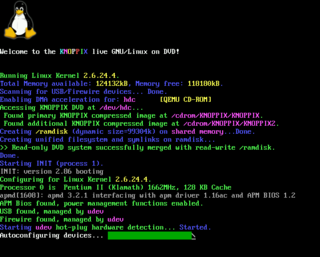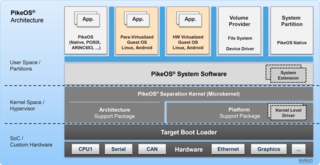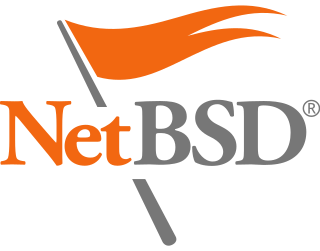
The Linux framebuffer (fbdev) is a linux subsystem used to show graphics on a computer monitor, typically on the system console.
Reiser4 is a computer file system, successor to the ReiserFS file system, developed from scratch by Namesys and sponsored by DARPA as well as Linspire. Reiser4 was named after its former lead developer Hans Reiser. As of 2021, the Reiser4 patch set is still being maintained, but according to Phoronix, it is unlikely to be merged into mainline Linux without corporate backing.

MontaVista Software is a company that develops embedded Linux system software, development tools, and related software. Its products are made for other corporations developing embedded systems such as automotive electronics, communications equipment, mobile phones, and other electronic devices and infrastructure.

Ingo Molnár, employed by Red Hat as of May 2013, is a Hungarian Linux hacker. He is known for his contributions to the operating system in terms of security and performance.
Exec Shield is a project started at Red Hat, Inc in late 2002 with the aim of reducing the risk of worm or other automated remote attacks on Linux systems. The first result of the project was a security patch for the Linux kernel that emulates an NX bit on x86 CPUs that lack a native NX implementation in hardware. While the Exec Shield project has had many other components, some people refer to this first patch as Exec Shield.
Computer operating systems based on the Linux kernel are used in embedded systems such as consumer electronics, in-vehicle infotainment (IVI), networking equipment, machine control, industrial automation, navigation equipment, spacecraft flight software, and medical instruments in general.
A dedicated hosting service, dedicated server, or managed hosting service is a type of Internet hosting in which the client leases an entire server not shared with anyone else. This is more flexible than shared hosting, as organizations have full control over the server(s), including choice of operating system, hardware, etc.
In computer security, executable-space protection marks memory regions as non-executable, such that an attempt to execute machine code in these regions will cause an exception. It makes use of hardware features such as the NX bit, or in some cases software emulation of those features. However, technologies that emulate or supply an NX bit will usually impose a measurable overhead while using a hardware-supplied NX bit imposes no measurable overhead.
Squashfs is a compressed read-only file system for Linux. Squashfs compresses files, inodes and directories, and supports block sizes from 4 KiB up to 1 MiB for greater compression. Several compression algorithms are supported. Squashfs is also the name of free software, licensed under the GPL, for accessing Squashfs filesystems.

PikeOS is a commercial hard real-time operating system (RTOS) which features a separation kernel-based hypervisor. This hypervisor supports multiple logical partition types for various operating systems (OS) and applications, each referred to as a GuestOS. PikeOS is engineered to support the creation of certifiable smart devices for the Internet of Things (IoT), ensuring compliance with industry standards for quality, safety, and security across various sectors. In instances where memory management units (MMU) are not present but memory protection units (MPU) are available on controller-based systems, PikeOS for MPU is designed for critical real-time applications and provides up-to-standard safety and security.

NTFS-3G is an open-source cross-platform implementation of the Microsoft Windows NTFS file system with read/write support. NTFS-3G often uses the FUSE file system interface, so it can run unmodified on many different operating systems. It is runnable on Linux, FreeBSD, NetBSD, OpenSolaris, illumos, BeOS, QNX, WinCE, Nucleus, VxWorks, Haiku, MorphOS, Minix, macOS and OpenBSD. It is licensed under the GNU General Public License. It is a partial fork of ntfsprogs and is under active maintenance and development.
AQuoSA is an open architecture for the provisioning of adaptive Quality of Service functionality into the Linux kernel. The project features a flexible, portable, lightweight and open architecture for supporting QoS related services on the top of a general-purpose operating system as Linux. The architecture is well founded on formal scheduling analysis and control theoretical results.
An embedded database system is a database management system (DBMS) which is tightly integrated with an application software; it is embedded in the application. It is a broad technology category that includes:

The Linux kernel is a free and open source, UNIX-like kernel that is used in many computer systems worldwide. The kernel was created by Linus Torvalds in 1991 and was soon adopted as the kernel for the GNU operating system (OS) which was created to be a free replacement for Unix. Since the late 1990s, it has been included in many operating system distributions, many of which are called Linux. One such Linux kernel operating system is Android which is used in many mobile and embedded devices.

Tomoyo Linux is a Linux kernel security module which implements mandatory access control (MAC).

NetBSD is a free and open-source Unix-like operating system based on the Berkeley Software Distribution (BSD). It was the first open-source BSD descendant officially released after 386BSD was forked. It continues to be actively developed and is available for many platforms, including servers, desktops, handheld devices, and embedded systems.
cgroups is a Linux kernel feature that limits, accounts for, and isolates the resource usage of a collection of processes.
OpenWrt is an open-source project for embedded operating systems based on Linux, primarily used on embedded devices to route network traffic. The main components are Linux, util-linux, musl, and BusyBox. All components have been optimized to be small enough to fit into the limited storage and memory available in home routers.
zswap is a Linux kernel feature that provides a compressed write-back cache for swapped pages, as a form of virtual memory compression. Instead of moving memory pages to a swap device when they are to be swapped out, zswap performs their compression and then stores them into a memory pool dynamically allocated in the system RAM. Later writeback to the actual swap device is deferred or even completely avoided, resulting in a significantly reduced I/O for Linux systems that require swapping; the tradeoff is the need for additional CPU cycles to perform the compression.

Zephyr is a small real-time operating system (RTOS) for connected, resource-constrained and embedded devices supporting multiple architectures and released under the Apache License 2.0. Zephyr includes a kernel, and all components and libraries, device drivers, protocol stacks, file systems, and firmware updates, needed to develop full application software.








